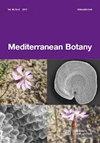Diversity and characteristics of the melliferous flora of Moroccan Macaronesia (Territory of Sidi Ifni)
IF 1
4区 生物学
Q3 PLANT SCIENCES
引用次数: 0
Abstract
The melliferous flora of Central Western Morocco, precisely in the territory of the Ait Baâmrane of Sidi Ifni Province was studied between 2016 and 2018 using surveys among beekeepers and by observing the behavior of bees towards flowers. The plants foraged by bees were collected, identified and listed. A total of 117 honey species were recorded, representing 41.64% of the 281 species of the total flora of the study area, belonging to 98 genera and 40 families. The Asteraceae family is the most represented with 17.95%, followed by Labiatae and Leguminosae with 6.84% each. The area is characterized by a high rate of endemism, estimated at 26.5% of the 117 melliferous species. However, there are species classified as rare and endangered taxa, estimated at 10 species. According to their biological types, Therophytes represent 36.75% of the foraged species, followed by Chamephytes (17.95%). Regarding the flowering period, it lasts throughout the year. Spring however is the most represented period with 42.45% of the plants, followed by summer with 28.98%, then winter and autumn, with 15.10% and 13.47% respectively. Melliferous plants with yellow flowers are the most attracted by bees (28.21%), followed by white flowers (24.79%). These listed plants are either foraged for their nectar and pollen (74.36%), only pollen (15.38%), or only nectar (8.55%). In addition, they have other uses, such as edible, medicinal, and others. It appears from this study that the conservation of the melliferous flora is very imperative in order to improve and promote the continuity of the beekeeping sector in the region.摩洛哥马卡罗内西亚(西迪伊夫尼领地)梅叶植物区系的多样性和特征
2016 年至 2018 年期间,通过对养蜂人进行调查和观察蜜蜂对花朵的行为,研究了摩洛哥中西部(确切地说是西迪伊夫尼省艾特巴姆兰境内)的多花植物区系。对蜜蜂觅食的植物进行了收集、鉴定和列表。共记录了 117 种蜂蜜,占研究地区植物区系总数 281 种的 41.64%,隶属于 98 属 40 科。其中菊科最多,占 17.95%,其次是唇形科和豆科,各占 6.84%。该地区的特点是地方特有性较高,在 117 个多孔植物物种中估计占 26.5%。不过,也有一些物种被列为稀有和濒危类群,估计有 10 种。根据其生物类型,苔藓植物占觅食物种的 36.75%,其次是蕨类植物(17.95%)。至于花期,全年都有。春季开花的植物最多,占 42.45%,其次是夏季,占 28.98%,然后是冬季和秋季,分别占 15.10%和 13.47%。蜜蜂最喜欢黄色花朵的多花植物(28.21%),其次是白色花朵(24.79%)。这些植物要么被蜜蜂采食花蜜和花粉(74.36%),要么只采食花粉(15.38%),要么只采食花蜜(8.55%)。此外,它们还有其他用途,如食用、药用等。从这项研究中可以看出,为了改善和促进该地区养蜂业的持续发展,保护蜜源植物区系势在必行。
本文章由计算机程序翻译,如有差异,请以英文原文为准。
求助全文
约1分钟内获得全文
求助全文
来源期刊

Mediterranean Botany
Agricultural and Biological Sciences-Plant Science
CiteScore
2.40
自引率
10.00%
发文量
30
审稿时长
12 weeks
期刊介绍:
Mediterranean Botany (ISSNe 2603-9109), formerly Lazaroa, is a biannual journal that publishes original research studies in the field of Botany including plant systematics, vegetation ecology, biogeography, evolutionary biology, ecophysiology, community ecology, ethnobotany and conservation biology on Mediterranean biomes but also in interacting areas.
Mediterranean Botany is an OPEN ACCESS Journal, free of charges for any published article.
 求助内容:
求助内容: 应助结果提醒方式:
应助结果提醒方式:


